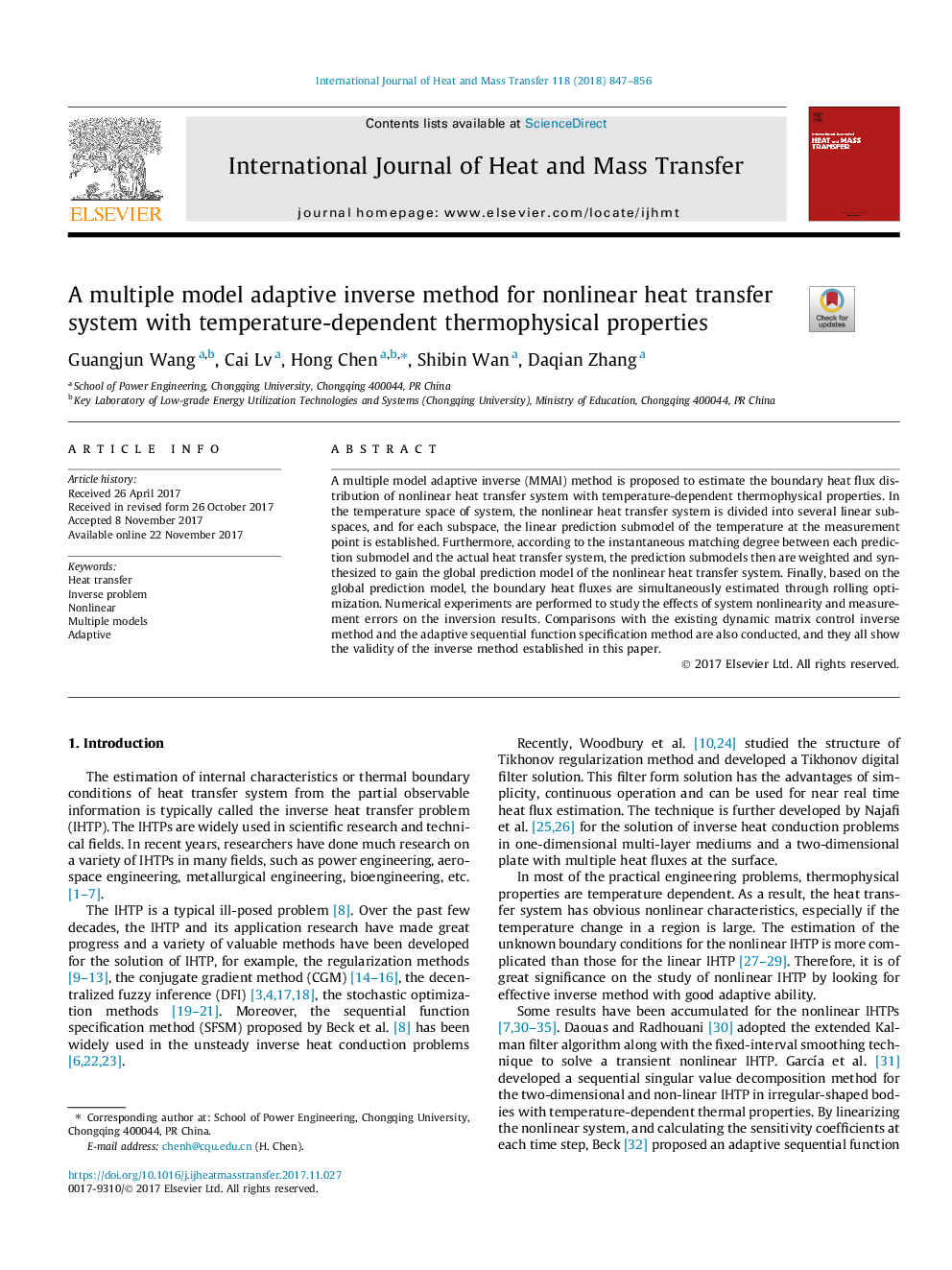| کد مقاله | کد نشریه | سال انتشار | مقاله انگلیسی | نسخه تمام متن |
|---|---|---|---|---|
| 7054804 | 1458022 | 2018 | 10 صفحه PDF | دانلود رایگان |
عنوان انگلیسی مقاله ISI
A multiple model adaptive inverse method for nonlinear heat transfer system with temperature-dependent thermophysical properties
ترجمه فارسی عنوان
یک روش معکوس تطبیقی چند متغیر برای سیستم انتقال حرارت غیرخطی با خواص ترموفیزیکی وابسته به دما
دانلود مقاله + سفارش ترجمه
دانلود مقاله ISI انگلیسی
رایگان برای ایرانیان
کلمات کلیدی
انتقال گرما، مشکل معکوس غیر خطی، چند مدل، سازگاری
ترجمه چکیده
برای تخمین توزیع شار حرارتی مرزی سیستم انتقال حرارت غیرخطی با خواص ترموفیزیک وابسته به دما پیشنهاد شده است. در فضای درجه حرارت سیستم، سیستم انتقال حرارت غیر خطی به چندین زیربنای خطی تقسیم می شود و برای هر زیرمجموعه، مدل پیش بینی خطی دما در نقطه اندازه گیری ایجاد می شود. علاوه بر این، با توجه به درجه تطبیق لحظه ای بین هر زیر مدل پیش بینی و سیستم انتقال حرارت واقعی، مدل های پیش بینی پیش بینی پس از آن وزن می گیرند و سنتز می شوند تا مدل پیش بینی جهانی سیستم انتقال حرارت غیرخطی به دست آید. در نهایت، براساس مدل پیش بینی جهانی، شار حرارتی مرزی به طور همزمان با بهینه سازی نورد برآورد می شود. آزمایش های عددی برای بررسی اثرات غیر خطی سیستم و خطاهای اندازه گیری بر روی نتایج معکوس انجام می شود. مقایسات با روش معکوس کنترل ماتریس پویا و همچنین روش تطبیق تابع تابع تطبیقی نیز انجام شده و همه آنها روش اعتبار روش معکوس موجود در این مقاله را نشان می دهند.
موضوعات مرتبط
مهندسی و علوم پایه
مهندسی شیمی
جریان سیال و فرایندهای انتقال
چکیده انگلیسی
A multiple model adaptive inverse (MMAI) method is proposed to estimate the boundary heat flux distribution of nonlinear heat transfer system with temperature-dependent thermophysical properties. In the temperature space of system, the nonlinear heat transfer system is divided into several linear subspaces, and for each subspace, the linear prediction submodel of the temperature at the measurement point is established. Furthermore, according to the instantaneous matching degree between each prediction submodel and the actual heat transfer system, the prediction submodels then are weighted and synthesized to gain the global prediction model of the nonlinear heat transfer system. Finally, based on the global prediction model, the boundary heat fluxes are simultaneously estimated through rolling optimization. Numerical experiments are performed to study the effects of system nonlinearity and measurement errors on the inversion results. Comparisons with the existing dynamic matrix control inverse method and the adaptive sequential function specification method are also conducted, and they all show the validity of the inverse method established in this paper.
ناشر
Database: Elsevier - ScienceDirect (ساینس دایرکت)
Journal: International Journal of Heat and Mass Transfer - Volume 118, March 2018, Pages 847-856
Journal: International Journal of Heat and Mass Transfer - Volume 118, March 2018, Pages 847-856
نویسندگان
Guangjun Wang, Cai Lv, Hong Chen, Shibin Wan, Daqian Zhang,
